| 21 May |
• yesterday • tomorrow |
| Optional Memorial of the Martyrs of the Mexican Revolution |
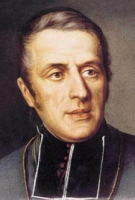
Charles Joseph Eugene de Mazenod
Eldest son of Charles-Antoine De Mazenod and Marie-Rose Joannis. His mother was of the French middle class, convent educated, and wealthy; his father was an aristocrat, classically educated, and poor. Their marriage, and Eugene's home life, were plagued by constant family in-fighting, and interference from his maternal grandmother and a neurotic maternal aunt. The women never let his father forget that they brought the money to the family.
On 13 December 1790, at age eight, Eugene fled with his family to exile in Italy to escape the French Revolution. He spent eleven years in Italy, living in Nice, Turin, Venice, Naples, and Palermo. While he learned Italian and German from dealing with people day to day, the bulk of his education came in Venice from Father Bartolo Zinelli, a local priest. In Palermo he was exposed to a wild and worldly life among rich young Italian nobles.
After the Revolution, his mother returned to France, but his father stayed in Italy, ostensibly for political reasons. Upon his own return to France in 1802 in an attempt to reclaim the family lands, Eugene tried to reunite his parents, but failed, and they were divorced, an unusual event in the early 19th century. His often unsupervised youth, the constant fighting at home, and the eventual break up of his family led to his patronage of dysfunctional families and those in them.
For years, Eugene struggled in himself, drawn on the one hand to the wordly life he knew from Palermo, and the beauty of the religious life he had seen in Venice with Don Bartolo. In an effort to work it out, Eugene began teaching catechism and working with prisoners in 1805. God won at last, assisted by a mystical experience at the foot of a cross on Good Friday 1807 when Eugene was momentarily touched by the full force of the love of God. He entered the seminary of Saint Sulpice, Paris in 1808. Ordained on 21 December 1811 at age 29 at Amiens, France.
Because of his noble birth, he was immediately offered the position of Vicar General to the bishop of Amiens. Eugene renounced his family's wealth, and preferred to become a parish priest in Aix-en-Provence, working among the poor, preaching missions and bringing them the church in their native Provencal dialect, not the French used by the upper classes. He worked among the sick, prisoners, the poor, and the overlooked young. Eugune contracted, and nearly died from, typhus while working in prisons.
Eugene gathered other workers around him, both clergy and laymen. They worked from a former Carmelite convent, and the priests among them formed the Missionaries of Provence who conducted parish missions throughout the region. They were successful, and their reputation spread, bringing requests for them outside the region. Eugene realized the need for formal organization, and on 17 February 1826 he received approval from Pope Leo XII to found a new congregation, the Oblates of Mary Immaculate founded on his core of missionaries.
Though he would have preferred to remain a missionary, Eugene knew that position with the Church hierarchy would allow him to insure the success of his little congregation. He was appointed Vicar-General of Marseille in 1823. Titular bishop of Icosia on 14 October 1832. Co-adjutor in 1834. Bishop of Marseilles, France on 24 December 1837, ordained by Pope Gregory XVI.
He founded 23 parishes, built or retored 50 churches, cared for aged and persecuted priests, restored ecclesiastical discipline, and developed catechetics for young people. Started work on the cathedral and shrine of Notre-Dame de la Garde in Marseille. Welcomed 33 congregations of religious brothers and sisters into the diocese. More than doubled the number of priests in his diocese, and celebrated all ordinations himself.
Eugene realigned parishes and maneuvered behind the scenes to weaken the government monopoly on education. He was an outspoken supporter of the papacy, and fought government intervention into Church matters. Publicly endorsed the dogma of the Immaculate Conception, and worked for its promulgation. His printed writings run to 25 volumes. Made a peer of the French Empire. Archbishop of Marseille in 1851 by Pope Blessed Pius IX. Helped Saint Emily de Vialar re-build the Sisters of Saint Joseph of the Apparition after their move to Marseille. Named senator and member of the Legion of Honour by Napoleon III in 1856. Proposed as cardinal in 1859.
On 2 December 1841, Bishop de Mazenod's first overseas missionaries arrived in Canada. By the time of his death in 1861, there were six Oblate bishops and over 400 missionaries working in ten countries. The Oblates continue their good work to this day with some 5,000 missionaries in 68 countries.
1 August 1782 at Aix-en-Provence, southern France as Charles Joseph Eugene de Mazenod
• 21 May 1861 at Marseille, France of cancer
• on 12 December 1936, his body was exhumed and found to be intact
• part of his heart is venerated at Blessed Sacrament Chapel at the Oblate-owned Lourdes Grotto of the Southwest in San Antonio, Texas, USA
3 December 1995 by Pope John Paul II at Saint Peter's Square, Rome, Italy
dysfunctional families
I am a priest, a priest of Jesus Christ. That says it all. - Saint Eugene
The Oblates [of Mary Immaculate] are the specialists of difficult missions. - Pope Pius XI
Go to Marseilles. There is a bishop there whose Congregation is still small, but the man himself has a heart as big as Saint Paul's, as big as the world. - contemporary bishop speaking of Bishop de Mazenod
Their ambition will be to encompass in their holy desires the immense breadth of the entire world. - Saint Eugene, speaking of his missionaries; at the time, there were ten of them
To love the Church is to love Jesus Christ, and vice versa. - Saint Eugene
We glorify God in the masterpiece of his power and love...it is the Son whom we honour in the person of his Mother. - Saint Eugene
Leave nothing undared for the Kingdom of God. - Saint Eugene
Learn who you are in the eyes of God. - Saint Eugene
Practice amongst yourselves charity, charity, charity...and zeal for the salvation of souls. - Saint Eugene to Oblate members as he lay dying
I find my happiness in pastoral work. It is for this that I am a bishop, and not to write books, still less to pay court to the great, or to waste my time among the rich. It is true...that this is not the way to become a cardinal, but if one could become a saint, would it not be better still? - Saint Eugene
If priests could be formed, afire with zeal for men's salvation, solidly grounded in virtue - in a word, apostolic men deeply conscious of the need to reform themselves, who would labor with all the resources at their command to convert others - then there would be ample reason to believe that in a short while people who had gone astray might be brought back to the long neglected duties of religion. We pledge ourselves to all the works of zeal that priestly charity can inspire... We must spare no effort to extend the Savior's Empire and destroy the dominion of hell. - Saint Eugene
Every religious congregation in the Church has a spirit all its own; it is inspired by the Spirit of God to respond to the needs of the Church to work for the salvation of souls. By our particular vocation we are involved with the redemption of humanity... May we, by the sacrifice of our whole being, so cooperate as not to render His redemption fruitless for ourselves and for those we are called upon to evangelize. - Saint Eugene
Servants! Farmhands! Peasants! Poor! Come and learn who you are in the eyes of God. You poor of Jesus Christ, you afflicted, unfortunate suffering, infirm, diseased: all you who are burdened with misery, listen to me! You are the children of God, brothers and sisters of Jesus Christ, co-heirs of His eternal kingdom, His cherished inheritance. Lift up your minds: you are the children of God. Look through the tatters that cover you. There is an immortal soul within you made to the image of God, a soul redeemed at the price of the very blood of Jesus, more precious in the eyes of God than all the riches and all the kingdoms of this earth. Know your dignity - you even share the Divine Nature - Children of God, Children of the Most High! - Saint Eugene
How should men who want to follow in the footsteps of their divine Master Jesus Christ conduct themselves if they are to win back the many souls who have thrown off his yoke? They must strive to be saints. They must walk courageously along the same paths trodden by so many before them who handed on splendid examples of virtue they must wholly renounce themselves, striving solely for the glory of God, the good of the Church, and the growth and salvation of souls. The Oblates are a Missionary Congregation. They are men set apart for the Gospel, men ready to leave everything to be disciples of Jesus Christ. Their principal service in the Church is to proclaim Christ and his kingdom to the most abandoned. They preach the Gospel among people who have not yet received it. Where the Church is already established, their commitment is to those groups it touches least. The mission of the Oblate is especially to those people whose condition cries out for salvation and for the hope which only Jesus Christ can fully bring. These are the poor with their many faces - they have our preference because of their need Our mission is to proclaim the kingdom of God and seek it before all else. We fulfill this mission in community; and our communities are a sign that in Jesus, God is everything for us. Together we await Christ's coming in the fullness of his justice so that God may be all in all. The cross of Jesus Christ is central to our mission. Like the apostle Paul, we "preach Christ and him crucified." If we bear in our body the death of Jesus, it is with the hope that the life of Jesus, too, may be seen in our body. Through the eyes of our crucified Savior, we see the world which he redeemed with his blood, desiring that those in whom he continues to suffer will know also the power of his resurrection. Growing in faith, hope and love, we commit ourselves to be a leaven of the Beatitudes at the heart of the world. Our mission requires that, in a radical way, we follow Jesus who was chaste and poor, and who redeemed mankind by his obedience. That is why, through a gift of the Father, we choose the way of the evangelical counsels. - extracts from the Rule of the Oblates of Mary Immaculate
https://catholicsaints.info/saint-eugene-de-mazenod/
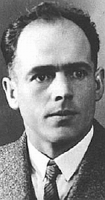
Franz Jaegerstaetter
Born to Rosalia Huber and Franz Bachmeier, servants too poor to get married. His father died in World War I when the boy was less than ten years old; his mother then married local famer Heinrich Jägerstätter who adopted Franz. Franz had little formal education, but his adoptive father was serious about the boy being able to read so that he could educate himself. At age 20 he began three years of work in the iron ore industry. He led a rather wild and dissolute life in his early 20's, but by his late 20's had settled down to life as a peasant farmer, became serious about his faith, married, and became the father of three daughters. He worked as sacristan for his parish, arranging funeral and prayer services, attended Mass daily, and developed a special ministry to the bereaved.
He became known as a vocal critic of the Nazis; he was the only one in his village to vote against Austrian unification with Germany in 1938, when greeted with "Heil Hitler" would respond "Pfui Hitler", and basically had no social life in the town because of his beliefs. When drafted into the army of the Third Reich, Franz could not reconcile such service with his faith; after a brief period served behind the lines, he refused to report for further service, was arrested, imprisoned in Linz, Austria, and Berlin, Germay, given a military trial, and finally executed. He spent time in prison praying, supporting other prisoners, and writing a series of letters and essays.
20 May 1907 in Sankt Radegund, Oberösterreich, Austria
beheaded on 9 August 1943 in Brandenburg an der Havel, Brandenburg, Germany
26 October 2007 by Pope Benedict XVI
I can say from my own experience how painful life often is when one lives as a halfway Christian; it is more like vegetating than living. - Blessed Franz in a letter to a god-child
Since the death of Christ, almost every century has seen the persecution of Christians; there have always been heroes and martyrs who gave their lives - often in horrible ways - for Christ and their faith. If we hope to reach our goal some day, then we, too, must became heroes of the faith. - Blessed Franz in a letter to a god-child
Everyone tells me, of course, that I should not do what I am doing because of the danger of death. I believe it is better to sacrifice one's life right away than to place oneself in the grave danger of committing sin and then dying. - Blessed Franz in a letter describing his moral dilemma over being drafted
Just as the man who thinks only of this world does everything possible to make life here easier and better, so must we, too, who believe in the eternal Kingdom, risk everything in order to receive a great reward there. Just as those who believe in National Socialism tell themselves that their struggle is for survival, so must we, too, convince ourselves that our struggle is for the eternal Kingdom. But with this difference: we need no rifles or pistols for our battle, but instead, spiritual weapons - and the foremost among these is prayer. Through prayer, we continually implore new grace from God, since without God's help and grace it would be impossible for us to preserve the Faith and be true to His commandments. Let us love our enemies, bless those who curse us, pray for Those who persecute us. For love will conquer and will endure for all eternity. And happy are they who live and die in God's love. - Blessed Franz, writing from prison
I can say with certainty that this simple man is the only saint I have ever met in my lifetime. - Father Jochmann, who ministered to Venerable Franz in prison
https://catholicsaints.info/blessed-franz-jagerstatter/
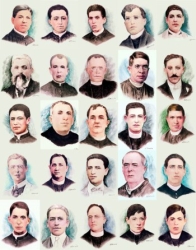
The 1917 Mexican constitution was pointedly anti-clerical and anti-Church, and its adoption instituted years of violent religious persecution including expulsion of foreign priests, closing of parochial schools, and the murders of several priests and lay leaders who work to minister to the faithful and support religious freedom. 25 of them who died at different times and places but all as a result of this persecution were celebrated together. They each have separate memorials, but are also remembered as a group.
• Saint Agustin Caloca Cortes
• Saint Atilano Cruz Alvarado
• Saint Cristobal Magallanes Jara
• Saint David Galván-Bermúdez
• Saint David Roldán-Lara
• Saint David Uribe-Velasco
• Saint Jenaro Sánchez DelGadillo
• Saint Jesús Méndez-Montoya
• Saint Jose Isabel Flores Varela
• Saint José María Robles Hurtado
• Saint Julio álvarez Mendoza
• Saint Justino Orona Madrigal
• Saint Luis Batiz Sainz
• Saint Manuel Moralez
• Saint Margarito Flores-García
• Saint Mateo Correa-Magallanes
• Saint Miguel de la Mora
• Saint Pedro de Jesús Maldonado-Lucero
• Saint Pedro Esqueda Ramírez
• Saint Rodrigo Aguilar Alemán
• Saint Roman Adame Rosales
• Saint Sabas Reyes Salazar
• Saint Salvador Lara Puente
• Saint Toribio Romo González
• Saint Tranquilino Ubiarco Robles
21 May 2000 by Pope John Paul II
https://catholicsaints.info/martyrs-of-the-mexican-revolution/
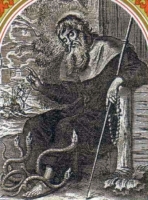
Godrick
Oldest of three children born to a freedman Anglo-Saxon farmer. An adventurous seafaring man, Godric spent his youth in travel, both on land and sea, as a peddler and merchant mariner first along the coast of the British Isles, then throughout Europe. Sometime sailor, sometime ship's captain, he lived a seafarer's life of the day, and it was hardly a religious one. He was known to drink, fight, chase women, con customers, and in a contemporary manuscript, was referred to as a "pirate". Converted upon visiting Lindisfarne during a voyage, and being touched by the life of Saint Cuthbert of Lindisfarne.
Pilgrim to Jerusalem and the holy lands, Saintiago de Compostela, the shrine of Saint Gaul in Provence, and to Rome, Italy. As a self-imposed austerity, and a way to always remember Christ's lowering himself to become human, Godric never wore shoes, regardless of the season. He lived as a hermit in the holy lands, and worked in a hospital near Jerusalem. Hermit for nearly sixty years at Finchale, County Durham, England, first in a cave, then later in a more formal hermitage; he was led to its site by a vision of Saint Cuthbert. It was a rough life, living barefoot in a mud and wattle hut, wearing a hair shirt under a metal breastplate, standing in icy waters to control his lust, living for a while off berries and roots, and being badly beaten by Scottish raiders who strangely thought he had a hidden treasure.
Noted for his close familiarity with wild animals, his supernatural visions, his gift of prophecy, and ability to know of events occurring hundreds or thousands of miles away. Counseled Saint Aelred, Saint Robert of Newminster, Saint Thomas Beckett, and Pope Alexander III. Wrote poetry in Medieval English. The brief song Sainte nicholaes by Godric is one of the oldest in the English language, and is believed to be the earliest surviving example of lyric poetry. He was said to have received his songs, lyrics and music, complete during his miraculous visions.
1069 at Walpole, Norfolk, England
1170 at Finchale, County Durham, England of natural causes
very old hermit dressed in white, kneeling on grass and holding a rosary, with a stag by him
One day there was a grand hunt near Godric’s hermitage. A magnificent stag was chased by the relations of Bishop Ramulf. The poor creature came panting to Godric’s cell, as if asking for refuge. Godric, on emerging from his retreat, saw it trembling with fear, and seeming to implore his help. Godric, indeed, took it into his cell, and the noble animal lay down at his feet. The hunters, however, soon came up and demanded their prey. Godric went to meet them. They asked him where the stag was. He answered, “God knows.” The hunters, recognising beneath the rags of the poor hermit an angel and a Saint, went away with their hounds without disturbing Godric or the stag any more, and the latter, to get over its fright, passed the night in the hermitage. The next morning it returned joyfully into the forest, and it came back several times a year to express its gratitude by caresses. Godric became the natural protector of the beasts in the forest pursued by the hunters: hares, deer, etc., when in danger, fled to him for safety. During the cold of winter the little birds warmed themselves in his breast; one would have said that they recognised in him the son of their merciful Creator. The hermit-pilgrim, Saint Godric, is often painted surrounded by serpents, because dangerous animals came to him without hurting him. – from "The Little Bollandists" by Monsignor Paul Guérin, 1882
https://catholicsaints.info/saint-godric-of-finchale/
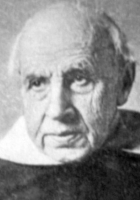
• Louis-Stanislas-Henri Cormier
• Henri Cormier Bracquemond
• 21 May (chosen in rememberance of the date of his election to Master of the Dominicans)
• 17 December (Martyrologium Romanum)
Born to a family of wealthy merchants, the son of François-Bernard Cormier and Marguerite-Felicité Bracquemond, he was baptized at the age of one day with the name Louis-Stanislas-Henri Cormier, but his family always called him Henri. His father died when Louis was a small boy, his brother soon after, and his uncle, a parish priest, helped raise him. Studied at home, then with the Christian Brothers, and entered the minor seminary in the diocese of Orléans, France at age 13. Could play the flageolet (a woodwind similar to a recorder), organ and ophicleide (a brass, trumpet-like instrument), and was known as a fine singer; Franz Liszt is reported to have admired Louis’ skills at the organ.
Henry became a Dominican tertiary while in seminary, graduated at the top of his class, and was ordained on 17 May 1856, having obtained a special dispensation as he was technically too young. Received the Dominican habit on 29 June 1856, taking the name Hyacinthe-Marie. Afflicted with a recurring hemorrhaging problem, he continued his studies and was allowed to make his profession on 23 May 1859 though everyone assumed it was on his death-bed. However, he survived, soon after made a complete recovery, and became active in his Order and his house.
Noted confessor and teacher, he is known to have written 171 texts in his life. Master of novices. Prior of the convent of Corbara in Corsica, France in 1863. Prior-Provincial of Toulouse, France from 1865 to 1874. Prior of the Dominican community in Marseilles, France. Served as Prior-Provincial again from 1878 to 1888. Definitor of the Dominican General Chapter of Lyons, France in 1891. Procurator of the Dominicans, working in Rome, Italy. In 1899 Pope Leo XIII considered elevating Father Hyacinthe-Marie to cardinal, but held off due to the political problems with France that would ensure over the appointment.
Served as the 76th Master of the Dominicans from 21 May 1904 until 1916. He restored many of the suppressed Dominican provinces, and helped the Order expand into western United States. Founded the Dominican Sisters of Saint Catherine of Siena of Auch. Noted and powerful preacher. Worked for the beatifications of Blessed Reginald of Orléans, Blessed Bertrand Garrigue, Blessed Raymond of Capua, and Blessed Andrew Abellon. Helped re-organize what became the Pontifical University of Saint Thomas Aquinas in Rome. He finally retired to live his remaining days as a prayerful monk at the priory of the Basilica of San Clemente in Rome.
8 December 1832 in Orléans, Loiret, France as Henri Cormier Bracquemond
• 12:30pm on 17 December 1916 at the priory of the Basilica of San Clemente in Rome, Italy of natural causes
• interred at the church of San Domenico e San Sisto, Pontifical University of Saint Thomas Aquinas, Rome in December 1934
20 November 1994 by Pope John Paul II
https://catholicsaints.info/blessed-hyacinth-marie-cormier/
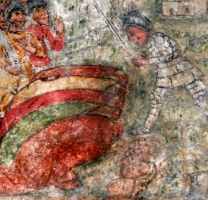
Restitude, Restitute, Ristituta
5 August (in Calenzana, Corsica, France which commemorates her intercession that miraculously ended a plague there)
We have two stories about this martyr, one medieval with limited information, the second later in composition, and much more colourful.
The oldest sources say that Restituta fled persecution in north Africa with five male companions (possibly the Martyrs of Noli). She evangelized the Balagne region of Corsica, and was martyred by Roman authorities during one of the imperial persecutions (dates vary).
The later documents say that she was born to a pagan family with ties to the imperial Roman army, converted to Christianity as a girl and was soon denounced to anti–Christian local authorities. She was beaten and stoned to get her to renounce Christianity. When she refused, she was thrown into a fire, but would not burn. She was then beaten with iron combs, but her wounds bled milk. These miracles converted several of the soldiers who were guarding and torturing her. She was then taken out to sea and thrown in to drown, but a chunk of cork floated her back to shore while the pagans on the boat were drowned. Her tormentors finally gave up on these slow, torturous methods of murder, and beheaded her with several other stubborn Christians. These martyrs then picked up the severed heads and walked to the place where the first chapel of Saint Restituta was built.
• beheaded 21 May in 217, 218, 225 or 303 (records vary)
• relics interred under the altar in the chapel of Saint Resistude in Calenzana in the 16th century and re-discovered during repairs in 1951
• Calenzana, Corsica, France (declared in 1984 by the Congregation for Divine Worship)
• Balagne, Corsica, France (declared in 1984 by the Congregation for Divine Worship)
https://catholicsaints.info/saint-restituta-of-corsica/
Colan, Gollen
Monk in Wales, Brittany and Cornwall. Believed to have travelled to Rome, Italy. Lived as a hermit in a small cave near Glastonbury Abbey. Abbot of a monastery in Wales. The Welsh town of Llangollen (Collen's enclosure), Clwd is named for him, indicating that it formed around his hermitage and church.
Collen was at the right time and place to be a transitional figure in the folklore of the region. There are tales of him slaying a Welsh giantess to save the people of Llangollen (the church there still has an image of him in this triumph), and of fighting a duel with a Saracen in front of the Pope. Stories have him being taken to the land of faerie, but always as a Christian, and always showing the power of God over the old ways.
Legend says that Collen was once invited to dine with the King of the Fairies; some say he was asked by a man, some say by a fairy, and some say by a talking peacock; I cannot say. The saint declined three times, but finally accepted. Though the king appeared to live in an enormous castle, wealthy and fair, surrounded by courtiers and servants, and seated before a table groaning under the weight of good eatings. Collen, however, knew him for the lying spirit he was. The saint reminded the king of the fate of the Godless, then sprinkled holy water in all directions; in an instant there was nothing left but an angry, demonic bird, flying away from the scene.
Another version has it that Collen, while he lived as a hermit near Glastonbury, was summoned to settle the eternal May Day struggle of Gwynn ap Nudd, Lord of the Underworld, with Gwyther, Lord of Summer, for the hand of the fair Creiddylad, the Maiden of Spring. Collen ordained that the quarrel would be resolved on Doomsday, and not before. Then with a sprinkle of holy water, the faerie folk and fortress disappeared.
c.600 in Wales
https://catholicsaints.info/saint-collen-of-denbighshire/
Born to the Italian nobility, the son of Giovanni, a senator and judge; his mother‘s name was Odolina. We know he had brothers, and was married at one point, but nothing else survives of his early life. Served in the court of Pope Innocent III. Chosen rector and papal governor of Orvieto, Italy in 1199, a turbulent area used as a base by Patarine Cathar heretics, and in the middle of endless struggles and machinations of the Guelphs and Ghibellines, between supporters of the Pope and those of the Emperor of Germany; Pietro was given a mission to bring peace and suppress heresy which meant he was welcomed with open arms by orthodox Catholics, with open opposition by the supporters of the various heresies and factions. Kidnapped by a gang of Patarine heretics, he was beaten and offered freedom if he would retract all anti–heresy laws in the area, and agree to never trouble the Patarines and Carthars again; he declined. Martyr. The backlash against his killers led to a popular uprising, suppression and exile of the heretics.
12th century Rome, Italy
• hit in the head with a hammer by Patarine heretic kidnappers on 21 May 1199 in a hut just outside Orvieto, Italy; other kidnappers stabbed his body numerous times with knives and swords
• buried in the graveyard of the church of Santa Maria in Orvieto
• relics in the Chapel of the Corporal in the cathedral of Orvieto
• popularly considered a martyr at the time of his death, there were commemorations beginning in 1200
• his tomb became a stopping point for people passing through Orvieto while on pilgrimages to Rome, Italy
• 16 March 1879 by Pope Leo XIII (cultus confirmation)
Orvieto, Italy
https://catholicsaints.info/blessed-pietro-parenzo/
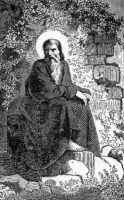
Ospicio, Sospis
Hermit at a place now named Cap-Saint-Hospice in his honour, living in the ruins of an old tower, wearing heavy iron chains, living off bread and dates and not even that during Lent. Foretold the invasion of Gaul by the Lombards. A Lombard patrol c.575, finding Hospitius loaded with chains and living in isolation, decided he was some type of criminal; Hospitius agreed that he was a terrible sinner, with a litany of offenses to his shame. Convinced he was a danger of some sort, one of the soldiers raised his sword to kill the old hermit; the soldier's sword arm became paralyzed, moving again only after Hospitius made the sign of the cross over it. The soldier was converted on the spot, and spent the rest of his life in service to God. Hospitius foretold the hour of his own death, spent his last hours in prayer, took off his chains, and passed on.
• 21 May 581
• buried by his friend, Austadius, Bishop of Cimiez
• relics distributed to the French towns of Lerins, Nice, Villefranche, La Turbie, and San-Sospis
https://catholicsaints.info/saint-hospitius-of-cap-saint-hospice/
Studied in Uppsala, Sweden and Paris, France; one of his classmates in Paris became Pope Clement VI. Priest. Canon of the cathedral of Åbo, Turku (in modern Finland) in 1329. Evangelizing bishop of Åbo in 1338 where he served for 28 years. He renewed the faith of his flock, improved the education, training and discipline of his priests, improved liturgical furnishings and diocesan finances, and worked for peace among the peoples of his area. Friend of Saint Bridget of Sweden.
late 13th century in Balinge parish, north of Uppsala, Sweden
21 May 1366 of natural causes
• miracles reported at his tomb, and by 1400 there were pilgrimages made to it
• Pope Leo X approves enshrining of his relics in the cathedral of Åbo, Turku (in modern Finland) in 1514
https://catholicsaints.info/blessed-hemming-of-abo/
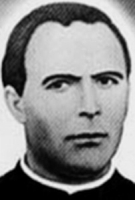
Ordained in 1902 in the archdiocese of Braga, Portugal. Transferred to the diocese of Frederico Westphalen, Brazil in 1913. Known as a concerned pastor to his flock, and for his social work in the region. Martyred with his altar boy, Blessed Adilo Daronche.
29 May 1877 in San José de Ribarteme, Pontevedra, Spain
21 May 1924 in Feijão Miúdo, Três Passos, Rio Grande do Sul, Brazil
21 October 2007 by Pope Benedict XVI
https://catholicsaints.info/blessed-manuel-gomez-gonzalez/
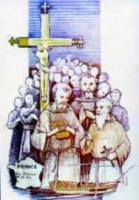
Brother Léon
Member of the Brothers of the Christian Schools, entering the novitiate on 14 January 1744. Imprisoned on a ship in the harbor of Rochefort, France and left to die during the anti–Catholic persecutions of the French Revolution. One of the Martyrs of the Hulks of Rochefort.
12 December 1724 in Rheims, Ardennes, France
21 May 1794 aboard the prison ship Deux-Associés, in Rochefort, Charente-Maritime, France
1 October 1995 by Pope John Paul II
https://catholicsaints.info/blessed-jean-mopinot/
Barrfoin, Barrindus
Led the church founded by Saint Columba in Drum Cullen, Offaly, Ireland in the 6th century. Later lived in Killbarron near Ballyshannon, Donegal, Ireland. Legend says that the sailed to America even before Saint Brendan the Navigator.
Irish
• Drumcuillan, County Laoghis, Ireland
• Killbarron, County Donegal, Ireland
https://catholicsaints.info/saint-bairfhion-of-killbarron/
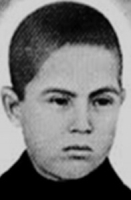
Young lay person in the diocese of Frederico Westphalen, Brazil. Martyr.
25 October 1908 in Dona Francisca, Cachoeira do Sul, Rio Grande do Sul, Brazil
martyred on 21 May 1924 in Feijão Miúdo, Três Passos, Rio Grande do Sul, Brazil
21 October 2007 by Pope Benedict XVI
https://catholicsaints.info/blessed-adilio-daronch/
Born to the Irish nobility. Priest. Benedictine monk. Abbot. Bishop. Having encountered opposition from a local lord, Silao went to Rome, Italy to appeal for support from Pope Gregory VII, but died on the road on the return trip.
early 11th century Ireland
• late 11th century in Lucca, Italy of natural causes
• relics in Lucca, Italy
https://catholicsaints.info/blessed-silao/
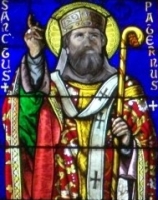
• Paternus the Elder
• Paterno, Patern, Pern
Fifth-century bishop of Vannes in Brittany (in modern France). Late in life he retired from his see to spend his final years as a hermit.
c.475
https://catholicsaints.info/saint-paternus-of-vannes/

Early desert monk whose unflinching dedication to the ascetic life was an example to many others at the beginning of the monastic movement. Pilgrim to Rome, Italy.
Egypt
356 of natural causes
https://catholicsaints.info/saint-serapion-the-sindonite/
Ayran, Ayrman
Benedictine monk. Martyred defending the altar at the monastery of Blèze, Côte-d'Or, France against Norman invaders.
in 888 at Blèze, Côte-d'Or, France
https://catholicsaints.info/saint-ageranus-of-beze/
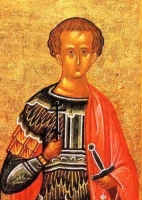
Polieuto, Polieutto
Martyr.
Caesarea, Cappadocia (in modern Turkey)
https://catholicsaints.info/saint-polieuctus-of-caesarea/
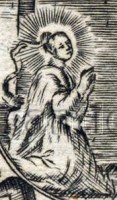
Itisberga
Sister of Charlemagne. Nun at Aire in the Artois region of France.
c.800 of natural causes
Artois, France
https://catholicsaints.info/saint-isberga/
Priest. Martyred along with a group of unnamed clergy in the persecutions of Constantius for opposing the Arian heresy.
Pentecost season, year unknown, at Alexandria, Egypt
https://catholicsaints.info/saint-secundus-of-alexandria/
Mercedarian priest. Confessor of King James II of Castille, and the Infanta Isabella.
1242
1342 at the Santa Eulalia Mercedarian convent in Barcelona, Spain of natural causes
https://catholicsaints.info/blessed-lucio-del-rio/
Benedictine monk. Martyred defending the altar at the monastery Blèze, Côte-d'Or, France against Norman invaders.
888 at Blèze, Côte-d'Or, France
https://catholicsaints.info/saint-genesius-of-bleze/
Priest. Martyred defending the altar at the monastery at Blèze, Côte-d'Or, France against Norman invaders.
in 888 at Blèze, Côte-d'Or, France
https://catholicsaints.info/saint-ansuinus-of-beze/
Benedictine monk. Martyred defending the altar at the monastery Blèze, Côte-d'Or, France against Norman invaders.
888 at Blèze, Côte-d'Or, France
https://catholicsaints.info/saint-berard-of-bleze/
Benedictine monk. Killed defending the altar at the Blèze Abbey, Côte-d'Or, France against Norman invaders.
888 at Blèze, Côte-d'Or, France
https://catholicsaints.info/saint-sifrard-of-bleze/
Benedictine monk. Killed defending the altar at the Blèze Abbey, Côte-d'Or, France against Norman invaders.
888 at Blèze, Côte-d'Or, France
https://catholicsaints.info/saint-rodron-of-bleze/
Soldier. Tribune in the imperial Roman army. Martyred with other soldiers.
Caesarea Philippi
https://catholicsaints.info/saint-nicostratus-of-caesarea-philippi/
Young boy. Martyred at the monastery of Blèze, Côte-d'Or, France against Norman invaders.
in 888 at Blèze, Côte-d'Or, France
https://catholicsaints.info/saint-adalric-of-beze/
Soldier. Tribune in the imperial Roman army. Martyred with other soldiers.
Caesarea Philippi
https://catholicsaints.info/saint-antiochus-of-caesarea-philippi/
Thibaud of Vienne
Archbishop of Vienne, France from 970 to 1001.
1001
https://catholicsaints.info/saint-theobald-of-vienne/
Deacon in Mauretania Caesariensis in North Africa. Martyred in the persecutions of Diocletian.
https://catholicsaints.info/saint-eutychius-of-mauretania/
Deacon in Mauretania Caesariensis in North Africa. Martyred in the persecutions of Diocletian.
https://catholicsaints.info/saint-timothy-of-mauretania/
Deacon in Mauretania Caesariensis in North Africa. Martyred in the persecutions of Diocletian.
https://catholicsaints.info/saint-polius-of-mauretania/
Bishop. Martyred with three boys whose names have not come down to us.
Auxerre, France
https://catholicsaints.info/saint-valens-of-auxerre/
Martyred in the persecutions of Diocletian.
c.306 in Cordoba, Spain
https://catholicsaints.info/saint-secundinus-of-cordoba/
Mancinelli
Sixth century bishop of évora, Portugal. Martyr.
https://catholicsaints.info/saint-mancio-of-evora/
Martyr.
Caesarea, Cappadocia (in modern Turkey)
https://catholicsaints.info/saint-victorius-of-caesarea/
Martyr.
Caesarea, Cappadocia
https://catholicsaints.info/saint-donatus-of-caesarea/
Martyr.
https://catholicsaints.info/saint-synesius-21-may/
Fourth century priest in France.
https://catholicsaints.info/saint-vales/
Martyr.
https://catholicsaints.info/saint-theopompus/
Large number of bishops, priests, deacons and lay people banished when the Arian heretics seized the diocese of Alexandria, Egypt in 357 and drove out Saint Athanasius and other orthodox Christians. Many were old, many infirm, and many, many died of abuse and privations while on the road and in the wilderness. Very few survived to return to their homes in 361 when Julian the Apostate recalled all Christians; and then many of those later died in the persecutions of Julian.
https://catholicsaints.info/martyrs-of-egypt/
An unspecified number of Christian clerics and lay people who, on Pentecost in 338, were rounded up by order of the Arian bishop and emperor Constantius, and were either killed or exiled for refusing to accept Arian teachings.
339 in Alexandria, Egypt
https://catholicsaints.info/martyrs-of-pentecost-in-alexandria/
CatholicSaints.Info Portable Edition